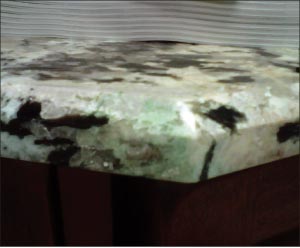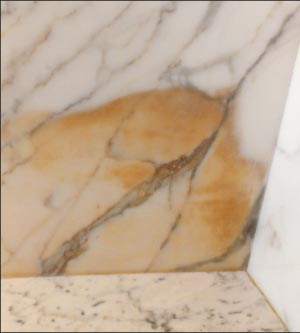The Stone Detective: Twelve Memorable Cases and Questions
Frederick M. Hueston, PhD
This old Stone Detective had a great holiday, but at my age, any day is a good day when I’m still breathing! I hope everyone got what they wanted for the holidays. I was thinking about the song “The Twelve Days of Christmas” and thought that I should answer the top twelve questions I get on a regular basis. Here we go.
1. My tiles are sounding hollow. Does this mean it’s a failed installation?
While hollow tiles can be a failed installation it may not necessarily be. Sound proofing can result in a false positive. The best way to tell is to have a destructive test performed to test the bonding.
 |
|
A typical blue-green stain caused by cyanoacrylate glue. CA stains occur as a reaction with the minerals in certain types of granite. |
2. I have a bluish-green stain on my granite countertop that the fabricator can’t seem to remove. Do I need to have it replaced or do you have any magic tricks to remove it?
I have lots of magic tricks but removing the stain will not require any magic. These stains are caused by using cyanoacrylate-type (CA) glue, and only occur on certain granites. The best way to remove them is to purchase a stain removal kit designed specifically for this type of stain.
3. After poulticing a stain on my countertop, it left a larger stain. What did I do wrong?
Sounds like you were on Santa’s Naughty List. All kidding aside, it most likely is not a stain but residual moisture from the poultice. To remove, sprinkle some dry poultice powder on the area and let it sit overnight. It should remove it. If not, then you are on the Naughty List.
4. We just installed a new bathroom shower with white marble and it is turning yellow. What is causing this?
Yellow stains on white marble showers is usually caused by smoking in the shower. Well, it could, but I don’t know many people who smoke in the shower. The most common cause of white marble turning yellow is iron oxidation. In other words, your stone is rusting. There is not a lot that can be done, but you can try a poultice and then have the shower sealed, which should reduce the chances of staining.
 |
|
There are few stains sadder than rusted marble. |
5. Someone told me that I should only use plain water to clean my stone floor? Is this good advice?
No, it is not good advice. Using only water to clean your floor–or anything else for that matter–will not work. Imagine taking a shower without using any soap (and I’m pretty sure I don’t want to imagine you not using any soap). The same thing goes for cleaning anything. Use a cleaner designed for stone surfaces and you will be OK, just don’t use it on yourself when you shower– LOL!
6. I was sitting in my living room the other night and heard a large popping sound. Someone said this could be my tile coming up. What are your thoughts?
You sure it wasn’t a drive- by shooting or perhaps your crazy neighbor shooting off some firecrackers? I have had several cases where homeowners have heard a large popping coming from their tile floors. This is a result of lack of expansion joints, and the tile is reacting under pressure. The tile releases from the floor causing the popping sound. So that is also the sound signaling, “It’s time for a new floor, installed properly, this time.”
7. I have noticed little white dots on my marble floor. What the heck are they and can then be removed?
Sounds like you may either need new glasses or someone is walking on your floor with high-heels or golf shoes. No kidding– sharp impacts from high-heels or golf shoes or anything similar will put these little white dots on certain types of marble. These are known as stuns or crystal fractures. Sadly, they rarely can be removed.
8. Like you, I am also a stone and tile inspector and one of my clients asked me if I could check his shower wall with a protimeter. I know I can Google it, but I want to know if you can tell me what the heck this is?
Well, it’s clear you haven’t attended my stone and tile inspection and troubleshooting class–I know, it’s a shameless plug. A protimeter is nothing more than a moisture meter.
9. I just installed a green marble tile floor and my client called and said it was curling on the edges. What the heck is going on, here?
OK, here is what you need to do. Take your right hand and slap yourself in the face. If the green marble is curling, you installed it with a water-based setting material. This is a big NO-NO. Go ahead slap yourself again, for good measure. This is a common problem with green (serpentine) marbles and you should have used an epoxy setting mortar. There is no fix, other than to tear it out and replace it.
10. I just finished fabricating a Giallo granite counter for a customer. The edges are a lighter color than the top. I have not had this problem before — and don’t tell me I don’t know how to polish edges.
OK, I won’t tell you. However, your problem has nothing to do with polishing technique. Chances are the slab is resined. The resin will darken over time, and if the slab was out in the sun, it has darkened. When you cut the edges, you exposed stone that was not exposed to the sun and hasn’t darkened. You will need to use a color enhancer to match the top.
11. We just had a large epoxy terrazzo floor installed in our lobby and it has all these bubbles appearing. What the heck is causing this?
Bubbling in epoxy terrazzo is a common problem and is caused by excessive moisture in the slab. The bubbling is the result of osmotic pressure lifting the terrazzo. Unfortunately, there is no fix. I would recommend you call a stone and tile inspector to perform a complete evaluation, and then you need to have a discussion with the general contractor or installer.
12. I am an engineer at a very large airport and our stone floor has these linear cracks that run across the floor every 15 feet or so. What is causing this?
This is a common problem when the installer bridges the construction joints in the slab. In other words, the installer just installed the tile right over these joints without using a fracture membrane, or placing expansion joints directly over the construction joints in the slab. This is a big NO-NO.
These are just a few of the hundreds if not thousands of questions I have received over 2016. If you have a question, send me an email and maybe it will show up in another one of my articles.
The Stone Detective is a fictional character created by Dr. Frederick M. Hueston, PhD, written to be entertaining and educational. Dr. Fred has written over 33 books on stone and tile installations, fabrication and restoration and also serves as an expert for many legal cases across the world. You can send your email comments to him at fhueston@stoneforensics.com.